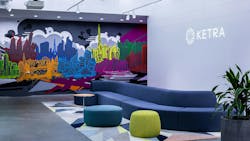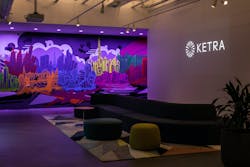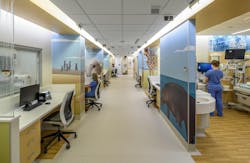Today’s solid-state marketplace offers an array of tunable LEDs, enabling the harnessing of different colors and color temperatures from one light source. However, there is a significant difference between tunable lighting and circadian LED technology that realistically mimics changing wavelengths of sunlight throughout the day to optimally stimulate the body’s natural release of serotonin in the morning and melatonin at night.
While the technology required to produce a product capable of tuning wavelengths to produce a bright white morning light and evolve into a soft, yellow light toward the day’s end is more complex, health and wellness-oriented lighting manufacturers, lighting designers, and progressive building owners are embracing the benefits of human-centric lighting (HCL).
In addition to the science proving the boosted productivity, better night’s sleep, and enhanced health benefits created by circadian lighting, Craig Casey, building science leader, Lutron Electronics, Coopersburg, Pa., states, “When the lighting is aligned with our mood and/or the task at hand, we feel more comfortable. That sense of well-being and comfort is what building owners and developers are looking to invest in. People want to spend time in places that make them feel good—and lighting is a big contributor to cultivating those feelings.”
“In office environments, we have seen boosts in productivity, alertness, mood, and nighttime sleep just from changing the lighting in the office to be biologically focused,” adds Robert Soler, vice president of biological research and technology, BIOS Lighting, San Marcos, Calif. “And in elderly care, we have seen reductions in falls and nighttime wandering by switching to circadian lighting.”
Circadian Basics
To enable this advanced level of light tuning, circadian LEDs are built based on a number of key principles. Spectrally optimized LED solutions tune to 490nm, which is the peak sensitivity of Melanopsin—the photo pigment that predominantly drives the human circadian system.
Another key metric is Equivalent Melanopic Lux (EML), which quantifies light effects on the human circadian cycle and assesses the response of the non-visual photo-receptors (ipRGCs) in the human eye. Another metric is the melanopic daylight efficacy ratio (m-DER), which quantifies the biological effect of an artificial light source as compared to 6500K of daylight. These calibrated metrics are also used to evaluate if a building qualifies for WELL Building standard circadian lighting level credits.
“While these are key attributes for HCL, we cannot simply forget about everything else we’ve valued and accomplished in SSL, such as high efficacy and high quality of light. We should not sacrifice other characteristics to achieve another, thus taking one step forward and two steps back,” cautions Erik Swenson, vice president, Nichia America Corp., Wixom, Mich.
Offering some general guidance in selecting high-quality tunable LED products, Soler instructs, “When looking at daytime melanopic ratios (MR), look for 3000K LEDs with an m-DER greater than 0.70, for 3500K look for an m-DER greater than 0.80, and for 4000K, look for an m-DER greater than 0.90.”
At the same time, simply tuning the correlated color temperature (CCT) can be misleading, says Swenson. For each CCT, designers still need to ensure that the light source provides a color rendering index (CRI) greater than 80 and a high R9 value, ideally greater than 90, according to Soler. The R9 value represents how accurately a light source reproduces strong red colors.
Product Innovations
Amongst the different advanced technologies on the market, the Ketra Natural Light product mimics what’s known as the black body locus curve which are the exact color temperatures found in nature.
“This advanced tuning solution gently shifts in color temperature and intensity throughout the day to help people feel more connected to nature when working, living, and playing indoors,” explains Casey.
While other products are capable of emitting this uniform light at wide angles for ambient lighting, when it comes to narrow beams for task or accent lighting, there is a risk of color breakup. Resolving this issue, Ketra’s TrueBeam Optics maintain homogenized light, delivering color uniformity across any beam.
Also patterning the black body locus is PERFEKTLight from Prolume. By incorporating a green LED, this supports a highly accurate replication in tuning a large range of less than 2400K to over 6000K.
“Throughout the day, sunlight varies from amber at sunrise to blue in midday and amber at sunset,” explains Zachary Teamer, senior director of marketing, Prolume. “PERFEKTLight’s output is exceptionally close to sunlight throughout the day and can be adapted to any location.“
Another innovation is BIOS’ SkyBlue technology, which has the ability to pinpoint the 490nm peak sensitivity of the melanopic ratio weighting curve. This then produces a very high melanopic ratio of 4000K (0.92 MR), 3500K (0.83 MR), and 3000K (0.74 MR). In pairing this with a nighttime spectrum as warm as 1800K, BIOS’ bio-dimming technology enables users to transition between the two spectrums using a single non-proprietary dimming interface.
“These light engines are designed specifically to meet the peak sensitivity of the circadian system while balancing color quality and source efficacy. This means users get the highest melanopic ratios, with brilliant color quality, at standard architectural CCTs,” explains Soler. To date, 36 different lighting manufacturers have partnered with BIOS to produce circadian luminaires and fixtures.
Another technology is Nichia’s Dynasolis, which is a tunable LED pairing developed to enhance the regulation of the body’s clock by combining Nichia’s non-visual, energizing Azure color (480nm) and a calming warm white LED, in addition to the visual color tuning element of human-centric lighting.
“The Azure LED stimulates the secretion of serotonin and leads to the normalization of the circadian rhythm,” explains Swensen. “During daytime activity hours, the color temperature can be increased to a refreshing, higher CCT, which is more equivalent to natural daylight, improving alertness and maintaining concentration levels. From the late afternoon, the light is gradually changed to a warmer CCT, allowing people to relax, feel more comfortable, and sleep more peacefully.”
Moving Forward
In a recent Lutron survey of New York-based lighting designers, 82% had already designed a tunable white project. However, it’s going to take more effort to make circadian and wellness lighting more accessible to building occupants. The continued application of new technologies and research and development are important, but the development of industry standards is key.
“As standards organizations like the Illuminating Engineering Society develop recommended practices for specifiers to design around circadian lighting, it is likely that we will see adoption increase,” projects Casey.
On the R&D side, just as Nichia developed its Dynasolis 2-in-1 color tuning technology out of a single light-emitting surface, Swenson anticipates the development of a similar technology with both color tuning and spectral tuning out of a single LED. “I hope the SSL market enables it to continue to evolve. There is a lot more that can be accomplished to improve the implementation of the technology,” concludes Swenson.
This article appeared in the September 2022 issue of Architectural SSL magazine.







